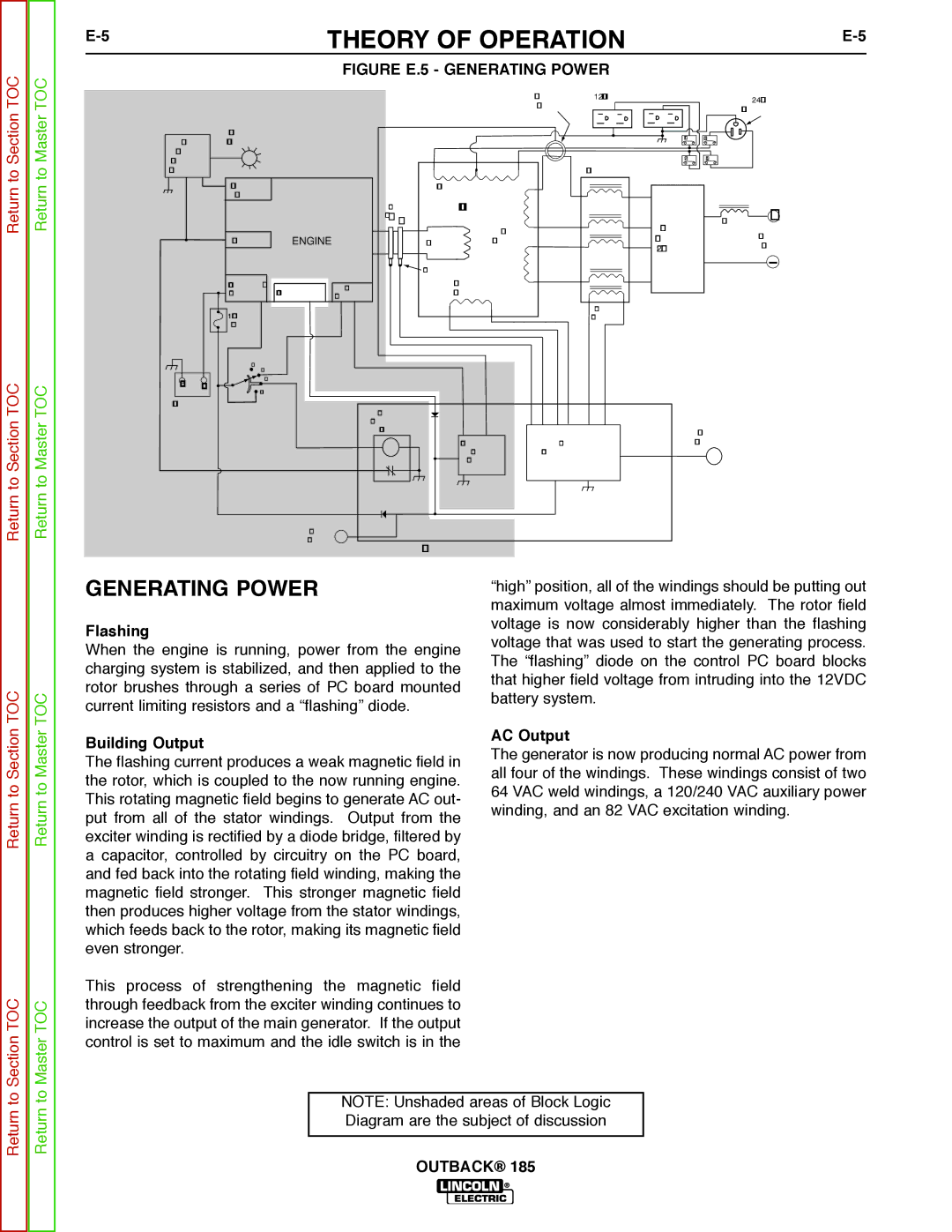
Return to Section TOC
Return to Section TOC
Return to Section TOC
Return to Section TOC
Return to Master TOC
Return to Master TOC
Return to Master TOC
Return to Master TOC
THEORY OF OPERATION | ||
|
FIGURE E.5 - GENERATING POWER
|
|
|
|
|
|
| CURRENT | 120 VAC RECEPTACLES |
| 240 VAC |
|
|
|
|
|
|
| SENSOR |
|
| |
|
|
|
|
|
|
|
| RECEPTACLE | ||
|
|
|
|
|
|
|
|
| ||
|
| OIL LEVEL |
|
|
|
|
| CB1 | CB3 |
|
OIL |
| INDICATOR |
|
|
|
|
|
| ||
|
|
|
|
|
|
|
|
| ||
LEVEL |
|
|
|
|
|
|
| CB2 | CB4 |
|
MODULE |
|
|
|
|
|
|
| |||
(KOHLER) |
|
|
|
|
| REACTOR |
|
| ||
|
| OIL LEVEL |
|
| AUXIIARY WINDINGS |
|
|
|
| |
|
| SWITCH |
| RINGS |
| STATOR |
|
|
|
|
|
|
|
| SLIP |
|
|
|
|
| + |
|
|
|
| _ + |
| WELD |
| OUTPUT | CHOKE | |
|
|
|
|
|
|
|
| OUTPUT | ||
|
| IGNITION | ENGINE |
| ROTOR | WINDINGS |
| RECTIFIER |
| |
|
|
|
|
| STUDS | |||||
|
|
|
|
|
|
|
| (2 PHASE) |
| |
|
|
|
|
| BRUSHES |
|
|
|
|
|
|
| STARTER / | ALTERNATOR | IDLE | EXCITER |
|
|
|
| |
|
| SOLENOID | SOLENOID | WINDING |
|
|
|
| ||
|
|
|
|
|
|
|
|
|
| |
|
| 10 AMP |
|
|
|
|
| BOOST |
|
|
|
|
|
|
|
|
| WINDING |
|
| |
|
| FUSE |
|
|
|
|
|
|
|
|
|
| OFFAUTO |
|
|
|
|
|
|
|
|
_ | + | HIGH |
|
|
|
|
|
|
| |
START |
|
|
|
|
|
|
|
| ||
|
|
|
|
|
|
|
|
|
| |
BATTERY |
|
| ENGINE |
|
|
|
|
|
| |
|
|
|
|
|
|
|
|
|
| |
|
|
|
| SHUTDOWN |
|
|
|
|
|
|
|
|
|
| RELAY |
|
|
| OUTPUT |
| |
|
|
|
|
|
| AUTOMATIC | OUTPUT | CONTROL |
| |
|
|
|
|
|
| IDLER | CONTROL CIRCUIT |
|
| |
|
|
|
|
|
| CIRCUIT |
|
|
|
|
|
|
| HOUR |
|
|
|
|
|
|
|
|
|
| METER |
| FIELD / CONTROL PC BOARD |
|
|
| ||
|
|
|
|
|
|
|
| |||
GENERATING POWER | “high” position, all of the windings should be putting out | |
| maximum voltage almost immediately. The rotor field | |
Flashing | voltage is now considerably higher than the flashing | |
voltage that was used to start the generating process. | ||
When the engine is running, power from the engine | ||
The “flashing” diode on the control PC board blocks | ||
charging system is stabilized, and then applied to the | ||
that higher field voltage from intruding into the 12VDC | ||
rotor brushes through a series of PC board mounted | ||
battery system. | ||
current limiting resistors and a “flashing” diode. | ||
| ||
Building Output | AC Output | |
The generator is now producing normal AC power from | ||
The flashing current produces a weak magnetic field in | ||
all four of the windings. These windings consist of two | ||
the rotor, which is coupled to the now running engine. | ||
64 VAC weld windings, a 120/240 VAC auxiliary power | ||
This rotating magnetic field begins to generate AC out- | ||
winding, and an 82 VAC excitation winding. | ||
put from all of the stator windings. Output from the | ||
| ||
exciter winding is rectified by a diode bridge, filtered by |
| |
a capacitor, controlled by circuitry on the PC board, |
| |
and fed back into the rotating field winding, making the |
| |
magnetic field stronger. This stronger magnetic field |
| |
then produces higher voltage from the stator windings, |
| |
which feeds back to the rotor, making its magnetic field |
| |
even stronger. |
|
This process of strengthening the magnetic field through feedback from the exciter winding continues to increase the output of the main generator. If the output control is set to maximum and the idle switch is in the
NOTE: Unshaded areas of Block Logic
Diagram are the subject of discussion
